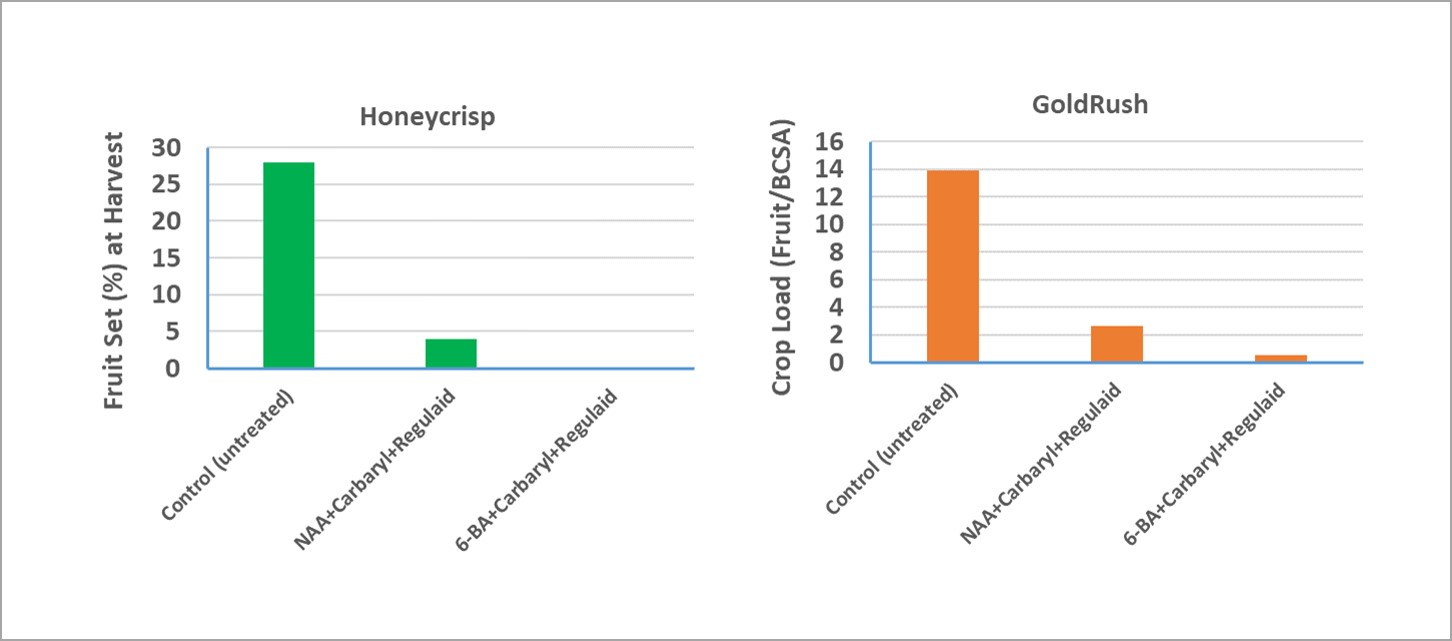Defruiting newly planted and young apple trees (e.g., 2nd and 3rd leaf) allows trees to fill their allotted bearing space, grow to the top wire and become ready to bear a decent crop by the fourth and fifth year. Although defruiting can be performed manually by removing flower clusters or by hand-thinning small fruitlets, many chemical options can make defruiting much more comfortable and less labor-dependent. These include:
a) Using blossom thinners: Two products of lime sulfur are now labeled for blossom thinning in Virginia. These are Rex lime sulfur and NovaSource lime sulfur. Two to three applications of lime sulfur at 3% (3 gallons/100 gallon per acre) mixed with oil (e.g., JMS Stylet-oil) at 2% will be enough to prevent the fertilization and fruit set of the majority of king and side blossoms. However, blossoms thinning sprays should be avoided when daytime temperatures are favorable for fire blight infections, e.g., between 75 to 85 oF, or when fire blight models (e.g., Maryblyt) predict blossom infections.
b) Using post-bloom thinners (recommended): chemical products containing 6-BA (e.g., Maxcel and Exilis 9.5SC) or NAA (e.g., Fruitone L, PoMaxa and Refine 3.5WSG) can be applied in combination with carbaryl (e.g., Sevin XL plus) to remove apple fruitlets. Two applications at fruit size 6-18 mm will be sufficient. 6-BA at 75-200 ppm or NAA at 10 ppm combined with carbaryl at 1 qt/100 gal/acre should achieve satisfactory results. However, it should be noted that NAA is not recommended for Fuji and Delicious. Defruiting with 6-BA or NAA will be more efficient if trees are under carbohydrate deficit conditions. The carbohydrate thinning model on NEWA (http://newa.cornell.edu/index.php?page=apple-thin) predicts the carbohydrate status of the tree based on daytime temperatures and solar radiation values. The best defruting conditions will be obtained if the model predicts a 4-day average balance of -40 to -80 g/day. If the model is not accessible, defruting sprays by 6-BA and NAA should be applied when daytime temperatures are ≥ 85 o. Cloudy days before and/or after defruting applications should also be targeted. Adding a non-ionic surfactant (e.g., Regulaid) to the spray tank will also enhance the efficacy of defruting applications.
The following figure shows the effect of two defruting treatments on fruit set (%) and crop load (fruit/branch cross-sectional area) of Honeycrisp and GoldRush trees, respectively. Treatments were applied twice at fruit size 6-18 mm.
c) Ethephon and carbaryl application: This combination will remove most fruit, but may cause tree growth reduction and increase flowering the following year. Use 1.0 to 1.5 pt of ethephon tank mixed with 1 qt of carbaryl and a surfactant or 1 qt of Superior oil/100 gal/acre. Apply when fruit are between 10 and 15 mm in diameter. Select a day when daytime high temperatures are expected to be between 70 and 90°F.


Interesting. Very interesting. I have never heard of it. I am very pleased to find this web-site. Thanks for sharing.